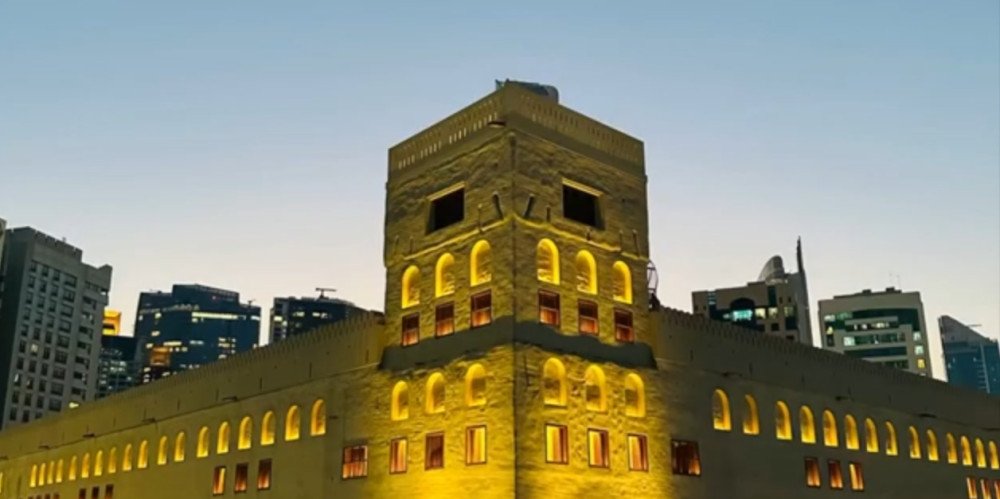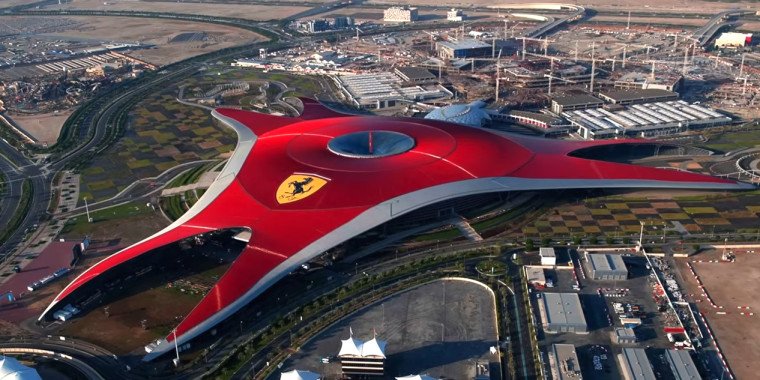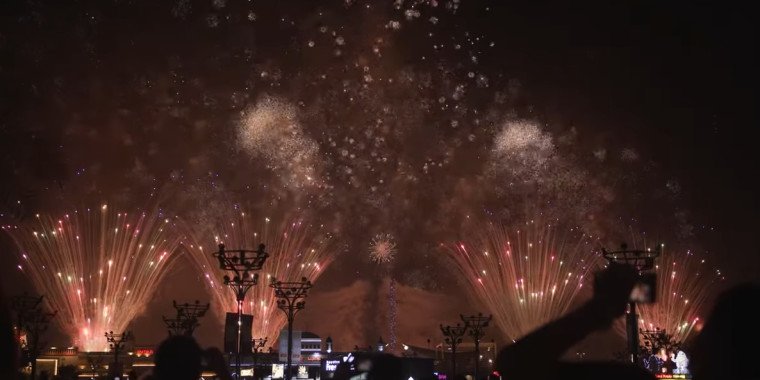
- On 06 Feb 2025
- In Travel
Qasr Al Hosn Abu Dhabi
Qasr Al Hosn is the oldest and most historically significant
building in Abu Dhabi. It stands as a symbol of Emirati heritage, governance
and cultural identity. It was built in the 18th century. Originally it served
as a watchtower before evolving into a fortress a ruling family residence and a
government headquarters. Now it has been carefully restored and transformed
into a museum. It offers visitors a deep insight into the history of Abu Dhabi,
the traditions of Emirati life and the legacy of the founding rulers of UAE.
Historical
Significance of Qasr Al Hosn Abu Dhabi:
Qasr Al Hosn is considered the birthplace of Abu Dhabi with
its origins tracing back to 1761. It was constructed as a watchtower to protect
the only freshwater well on the island. Over time it was expanded into a
fortified stronghold and served as the residence of the ruling Al Nahyan
family. Qasr Al Hosn was the political and cultural heart of the region for
nearly two centuries and played a crucial role in the governance and
unification of the Emirates. Qasr Al Hosn remained a symbol of resilience and
leadership as Abu Dhabi transitioned from a pearl diving and trading hub to an
oil rich metropolis. Now a days Qasr Al Hosn stands as a museum and heritage
site to preserve the rich past of UAE.
Architectural
Heritage of Qasr Al Hosn Abu Dhabi:
The architecture of Qasr Al Hosn reflects the ingenuity and
adaptability of early Emirati builders. They used coral stones, palm wood and
gypsum to withstand the harsh desert climate. The fortress like structure
features thick defensive walls, watchtowers and a grand central courtyard which
once served as the gathering place of ruling family. A key architectural
highlight is the Inner Fort which was constructed in 1795. Later on it was expanded
into a larger palace complex in the 20th century. The watchtower stands at the
heart of the fort and remains as one of the oldest surviving structures in the
UAE. It offers visitors a glimpse into military and defensive history of Abu
Dhabi. The careful restoration of Qasr Al Hosn ensures that its original
grandeur and authenticity are preserved for generations to come.
Qasr Al Hosn Museum:
The Qasr Al Hosn Museum offers a fascinating multimedia
exhibition that tells the story of transformation of Abu Dhabi over the
centuries. You can explore photographs, historical documents and artifacts that
provide insight into the lives of the ruling Al Nahyan family. Qasr Al Hosn has
been transformed into a living museum to preserve the story of the ruling Al
Nahyan family, the history of Abu Dhabi and the evolution of Emirati culture. Below
is the detail of Qasr Al Museum.
·
The First
Watchtower: One of the most fascinating exhibits explores the origins of
Qasr Al Hosn which date back to 1761. It was first built as a watchtower to
protect only freshwater well of Abu Dhabi. This section includes architectural
drawings, historical accounts and reconstructions of what the original
watchtower looked like. It also offers old maps of Abu Dhabi, ancient well
preservation techniques, 3d models and digital reconstructions to illustrate the
history how the watchtower evolved into a fortress and royal residence. This
exhibit provides a foundation for understanding the early days of Abu Dhabi and
the strategic role Qasr Al Hosn played in protecting its people.
·
The
Evolution of Qasr Al Hosn: This section of the museum delves into the
transformation of Qasr Al Hosn from a defensive fort into a ruling palace. The
fort was expanded into a larger fortress to serve as the official residence of
the ruling Al Nahyan family and later as the political and administrative
center of Abu Dhabi over the centuries. This part offers archival photographs
of Qasr Al Hosn, original architectural elements, including preserved walls,
watchtowers, and wooden doors. It also displays a timeline of rulers of Abu
Dhabi explaining how the fort was a seat of power for nearly two centuries and
artifacts used by the ruling family, such as furniture, majlis seating and
ceremonial items.
·
Traditional
Governance and Leadership: One of the most insightful exhibits at Qasr Al
Hosn Museum focuses on Emirati governance and leadership traditions. This
section tells the story of how Abu Dhabi was ruled before the modern UAE was
formed to emphasize the role of the majlis (council) and where the rulers made
key decisions. The have reconstructed a majlis (royal council chamber) where
visitors can experience how leaders met with citizens to discuss laws, trade
and social issues. This part also display the historical documents and letters
which include early trade agreements, treaties and governance records. Personal
belongings of Sheikh Zayed bin Sultan Al Nahyan is also included his traditional
attire, handwritten notes and gifts from world leaders.
·
Emirati
Life and Culture: This part is dedicated to the daily lives of Emiratis
before the discovery of oil which offer a look at how people lived, worked and
interacted with their environment. They have recreated traditional Emirati homes,
showing how families lived in palm frond houses (Areesh) and stone dwellings.
They have displayed the traditional Emirati attire, including kanduras for men,
abayas for women, intricate gold jewelry cooking tools and kitchenware. This
section provides an intimate and personal insight into the traditions and
lifestyle of early Emirati society.
·
The Pearl
Diving Industry: Pearl diving was the main source of wealth in the region
before the discovery of oil. This exhibit showcases the risks, hardships and rewards
of pearl diving which shaped the economy of Abu Dhabi for centuries. The original
pearl diving equipment like diving masks, ropes oyster baskets, interactive
pearl trading simulations, model of a traditional pearling dhow boat and rare
natural pearls are also displayed here. This exhibit is one of the most fascinating
parts of the museum which tells the story of the people who built economy of
Abu Dhabi long before oil wealth was discovered.
·
Weapons
and Defense: Qasr Al Hosn was a key defensive structure to protect Abu
Dhabi from raids and external threats. This section of the museum focuses on
the military history of the region and displays the weapons, armor and defense
strategies used over the centuries. Traditional Emirati swords, daggers, muskets,
restored watchtower, Cannon and gunpowder storage areas is displayed in this
section. Stories of famous battles and conflicts portrayed here which reveal
how Abu Dhabi maintained its independence and security.
·
The
Modernization of Abu Dhabi: The final section of the museum takes visitors on
a journey through modernization of Abu Dhabi by focusing on the rapid
development of the city after the discovery of oil in the 20th century. This
section display photographs before and after transformation of Abu Dhabi from a
desert settlement to a world class metropolis. It also display original plans
and models of modern Abu Dhabi landmarks like the Corniche, Sheikh Zayed Grand
Mosque and Louvre Abu Dhabi.
The House of Artisans at Qasr Al
Hosn:
The House of Artisans at Qasr Al Hosn is a cultural and
creative hub dedicated to preserving and promoting traditional Emirati
craftsmanship. By visiting this section you can witness live demonstrations and
participate in hands on workshops. The space is both an exhibition and a
learning platform to ensure that ancient craftsmanship remains alive and
continues to inspire future generations.
·
A
Celebration of Traditional Emirati Crafts: The House of Artisans was
established to protect and revive Emirati crafts that have been practiced for
centuries. Local artisans used natural materials from the desert, sea, and palm
groves to create practical and decorative items before the discovery of oil. At
the House of Artisans, visitors can explore a curated collection of handcrafted
Emirati artifacts, live demonstrations by skilled artisans and hands on
experiences where visitors can try weaving, embroidery and other traditional
crafts. By celebrating these traditions, the House of Artisans helps to
preserve the cultural identity of UAE.
·
Sadu
Weaving: One of the most significant crafts on display at the House of
Artisans is Al Sadu weaving. Sadu weaving is a Bedouin textile making technique
that has been practiced for centuries. This art form involves hand spinning
wool from camels, sheep and goats which is then woven into beautifully
patterned fabrics used for tents, rugs and traditional clothing. You can see live demonstrations by Emirati women showcasing the
spinning, dyeing and weaving of fabric. UNESCO has recognized Al Sadu as on the
List of Intangible Cultural Heritage in need of urgent Safeguarding.
·
Talli
Embroidery: Talli is a delicate form of Emirati embroidery which is traditionally
used to decorate garments of women. This intricate technique involves hand braiding
metallic threads of gold, silver and silk into detailed patterns. You can see
the live demonstrations where artisans weave metallic threads into elaborate
designs. You can also see a showcase of bridal and ceremonial dresses adorned
with Talli embroidery.
·
Khoos: Palm
frond weaving or Khoos is another essential Emirati craft that was widely used
in daily life. Early Emirati communities relied on woven palm fronds to create
baskets, mats, fans and even roofing for homes. Traditional palm weaving
demonstrations showcase how artisans turn natural palm leaves into intricate
designs.You can see a display of woven household items like food covers,
decorative wall hangings and floor mats.
·
Pottery
and Ceramics: Pottery has been an important part of Emirati culture for
thousands of years dating back to prehistoric settlements in the region. The
House of Artisans displays traditional Emirati pottery used for food storage, cooking
and water preservation. You can see the live pottery making demonstrations
where artisans shape clay using hand spinning and firing techniques. You can
also see a collection of historical pottery artifacts.
·
The Art
of Perfumery: Emirati culture places great importance on perfumery and
natural fragrances. Perfumery has been an essential part of social customs,
hospitality and religious rituals. The House of Artisans provides an in depth
look at how traditional perfumes are made with natural ingredients such as oud,
rose and frankincense. You can see the Demonstrations of how natural oils and
ingredients are blended, creating customized fragrances. Perfumery is a craft
that continues to play a vital role in Emirati identity.
The Cultural
Foundation – A Modern Center for Arts and Heritage:
The cultural foundation is located within the Qasr Al Hosn
complex. The Cultural Foundation serves as a contemporary hub for art,
literature and performing arts. It was originally established in 1981 as first
cultural institution of Abu Dhabi and has since been revitalized to foster artistic
expression and creativity. It has art Galleries and Exhibitions which showcase
local and international contemporary artists. Cultural foundation also has a
performance Theater which host music concerts, dance performances and poetry
readings. A Library is also there which provide resources for students,
researchers and literature enthusiasts. The Cultural Foundation ensures that
Emirati culture continues to thrive in a contemporary setting by blending
heritage with modern artistic innovation.
Events and
Festivals at Qasr Al Hosn
Qasr Al Hosn is not just a historical landmark it is also a
dynamic cultural hub for hosting some of most significant events and festivals
Abu DHabi. The site comes alive with heritage celebrations, traditional performances,
educational workshops, and national festivities throughout the year. The major
events that are being celebrated in Qasr Al Hosn are,
·
Qasr Al
Hosn Festival: The Qasr Al Hosn Festival is the biggest and most
anticipated cultural event held annually at the fort. This festival is a
celebration of history, traditions and national identity of Abu Dhabi. They present live historical reenactments that
depict life in Abu Dhabi centuries ago to show how the ruling family, traders
and pearl divers lived. Traditional Emirati performances include Al Ayala
(stick dance), Al Razfa (sword dance) and storytelling sessions. Craftsmen
demonstrate Sadu weaving, palm frond basket making and Talli embroidery. Visitors
can purchase authentic Emirati handicrafts, perfumes, spices and jewelry from
heritage souks during the festival. Food stalls serve traditional Emirati
dishes such as Machboos, Harees, and Luqaimat. The Qasr Al Hosn Festival is a
deeply cultural experience.
·
UAE
National Day Celebrations at Qasr Al Hosn: UAE celebrates National Day
Every year on December 2nd to mark the formation of the United Arab
Emirates in 1971. Qasr Al Hosn is a symbol of the national history and
leadership and plays a central role in these grand celebrations. In these
celebrations patriotic performances like military parades, traditional Emirati
songs and flag raising ceremonies are highlights. Cultural exhibitions which
showcase rare historical documents, photographs and artifacts from the founding
of UAE also showcase to visitors. Special workshops for families and children
and Fireworks and light shows are also an integral part of celebrations. The
UAE National Day celebrations at Qasr Al Hosn are a powerful tribute to the
unity, progress and heritage of the Emirates.
·
Traditional
Music and Dance Performances: Qasr Al Hosn hosts live traditional music and
dance performances throughout the year to provide a lively and immersive
experience of Emirati artistic heritage. These performances bring folk
traditions to life which allows visitors to witness the energy, rhythm and
cultural depth of the performing arts of UAE. Al Ayala Dance, Al Razfa Sword
Dance, Liwa and Harbiya Music Performances are presented which originate from
the Bedouin and seafaring communities. Poetry and Storytelling Nights are a
form of classical Arabic poetry that captures Emirati wisdom and storytelling
traditions. These performances connect the past to the present to ensure that
Emirati cultural traditions remain alive and celebrated.
·
Ramadan
and Eid Festivities at Qasr Al Hosn: During Ramadan and Eid, Qasr Al Hosn
becomes a place of spiritual reflection, cultural engagement and family
festivities. Visitors can experience the customs and traditions of the holy
month along with participating in celebratory Eid events. Guests can enjoy a
traditional meal during Iftar and Suhoor which feature dates, Arabic coffee and
authentic Emirati dishes. Religious and cultural storytelling explains the
significance of Ramadan in Emirati history. Lantern lit evening performances
include recitations of old folktales, poetry and traditional music. Eid Al Fitr
and Eid Al Adha celebrations feature cultural parades, family friendly
activities and festive performances. These events offer a unique cultural
experience to showcase the importance of faith, family and hospitality in
Emirati society.
·
Emirati
Craftsmanship and Heritage Workshops: Qasr Al Hosn regularly hosts
interactive workshops where visitors can learn about and engage in traditional
Emirati crafts and skills. These sessions are led by master artisans to
preserve and passing down the ancient craftsmanship techniques that have been
part of Emirati culture for centuries. In Sadu Weaving Demonstrations visitors
can learn how Bedouin women wove intricate patterns into textiles using wool
and camel hair. In Pearl Diving Experiences guests can try opening oysters and
learning about the historical pearl trade of Abu Dhabi. In Calligraphy
Workshops visitors can learn the art of Arabic script writing using traditional
ink and parchment. In Palm Frond Weaving (Khoos) visitors can create their own
woven baskets, mats and decorative items and in Talli Embroidery Sessions
visitors can learn the delicate process of gold and silver-thread embroidery
used in Emirati dresses. These workshops provide a hand on opportunity to
engage with Emirati traditions which makes Qasr Al Hosn a hub of cultural
learning and preservation.
·
Special
Exhibitions and Historical Reenactments: Qasr Al Hosn frequently hosts
temporary exhibitions and live reenactments to bring history to life through
immersive storytelling and interactive experiences. Rare Artifacts and Historical
Displays which feature weapons, tools and personal items used by ruling family of
Abu Dhabi and early settlers. 3D Digital Reconstructions allows visitors to see
how Qasr Al Hosn evolved over time. These exhibitions offer a unique way to
experience the history of Abu Dhabi to blend education with entertainment.
Visitor Experience:
A visit to Qasr Al Hosn is a step back in time which offers
a unique blend of history, culture and art. Guests gain a deeper appreciation
of the rich heritage of UAE by exploring the historic walls of fortress,
engaging with Emirati artisans or attending cultural performances.
Location of Qsar Al Hosn: Sheikh Rashid Bin Saeed Al Maktoum
Street, Abu Dhabi, UAE
Opening Hours: 9:00 AM – 8:00 PM (Daily)
Entry Fee: AED 30 for adults, AED 15 for children (under 12), free
for children under 5
Accessibility: Easily accessible by car, taxi, and public
transport, with parking facilities available
Qasr Al Hosn is more than just a historic fort. It is the
soul of Abu Dhabi to preserve centuries of Emirati heritage, culture and
leadership. This iconic site offers a profound and enriching experience whether
you are fascinated by history, craftsmanship or traditional Emirati life. It
remains a powerful reminder of the journey of nation from a small desert
settlement to a thriving global capital as the oldest standing structure in the
UAE.


